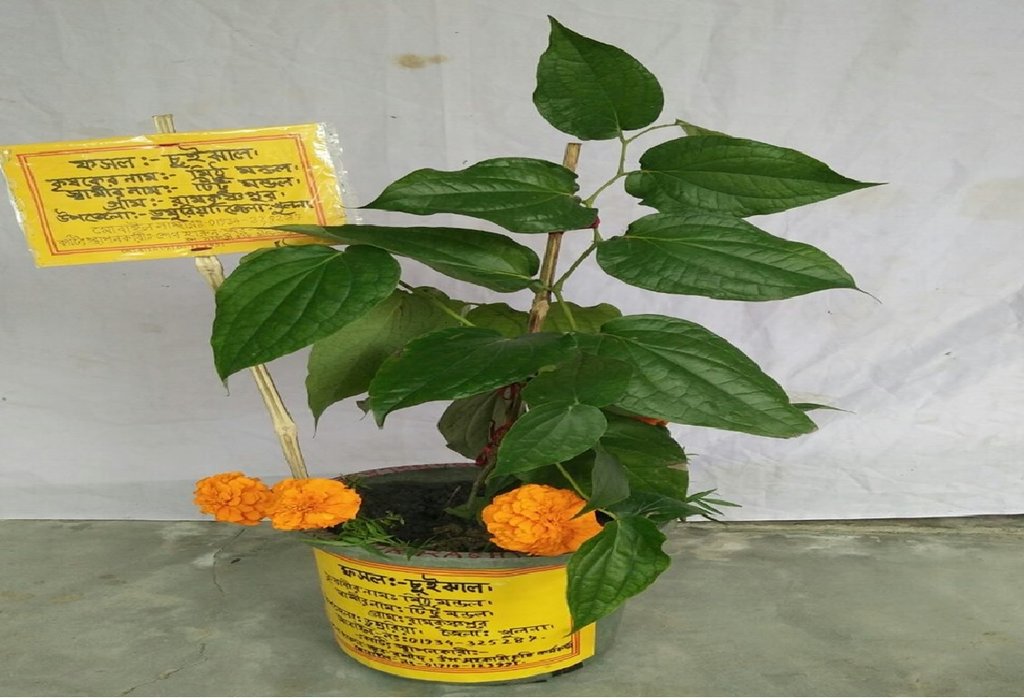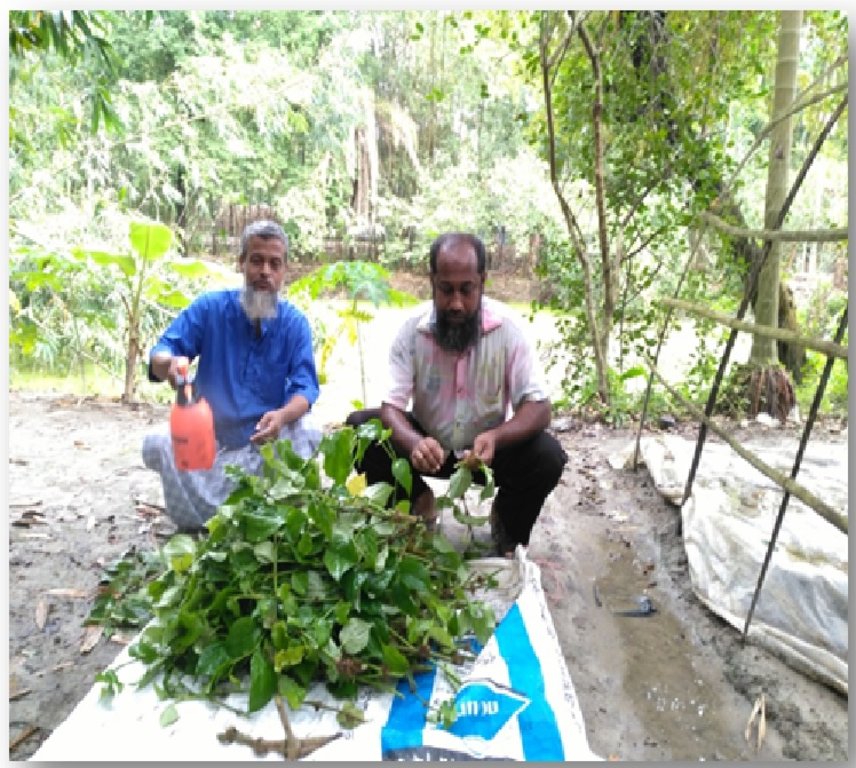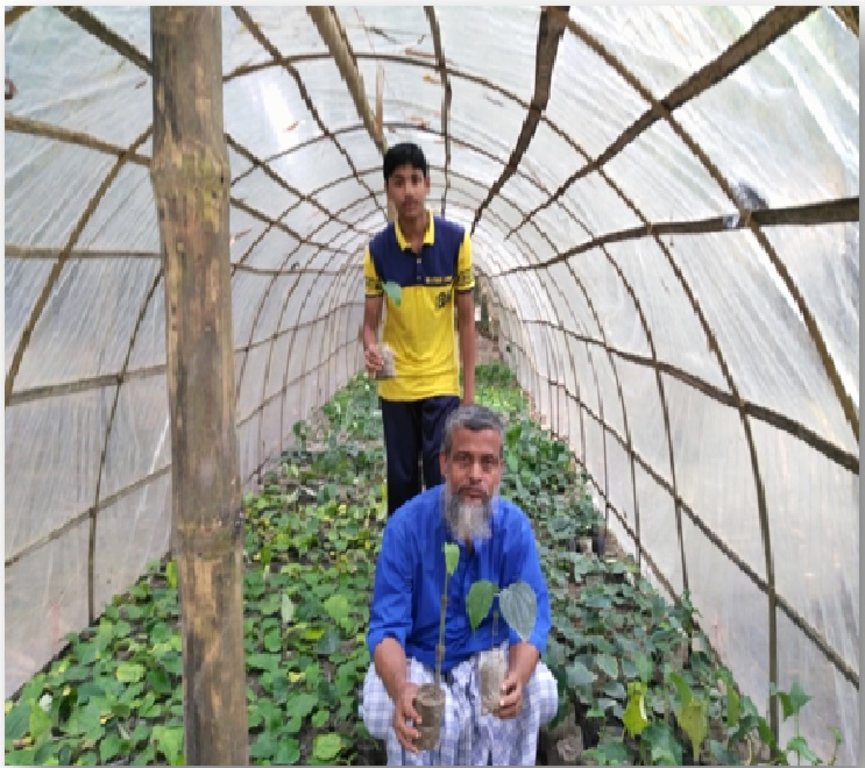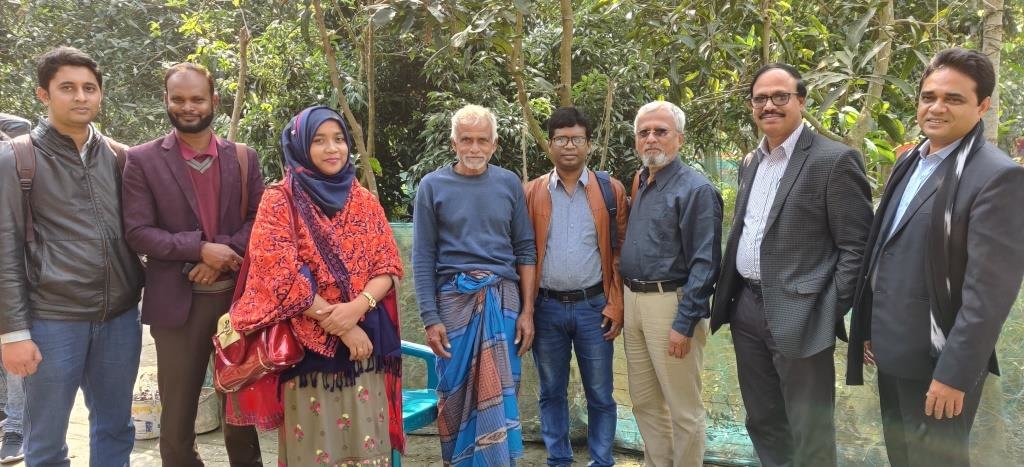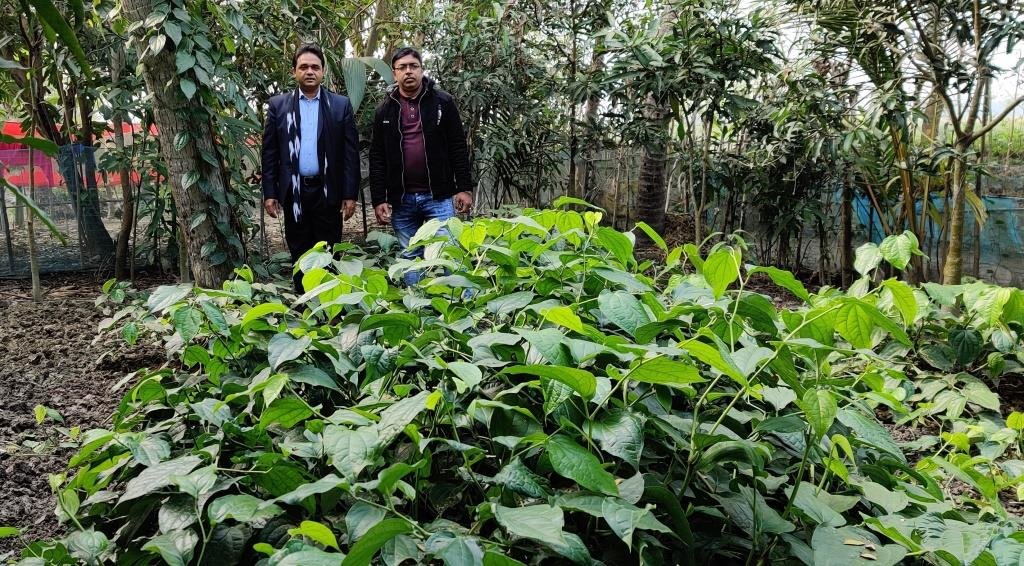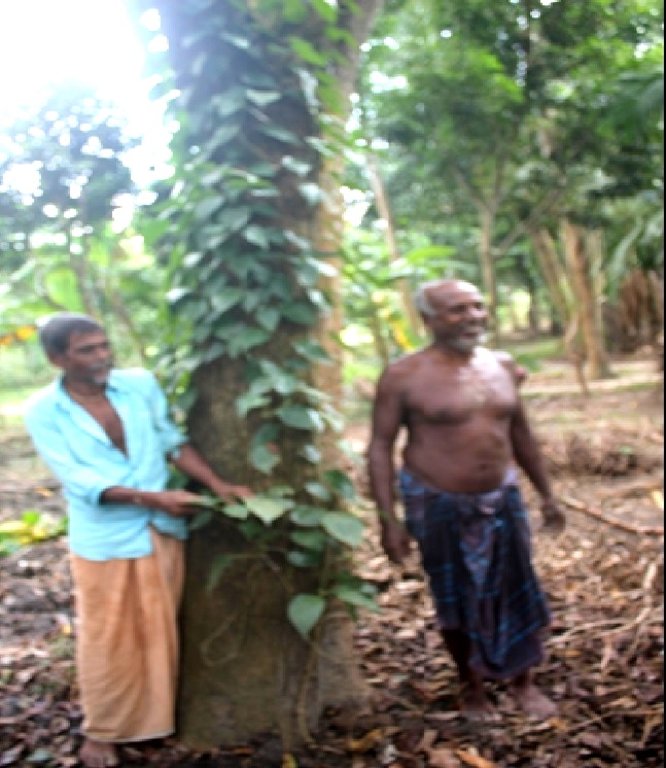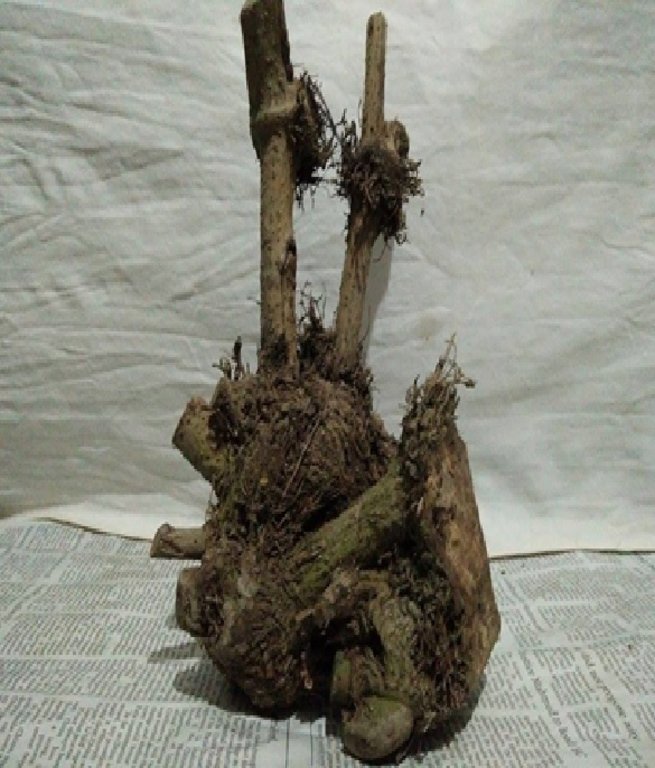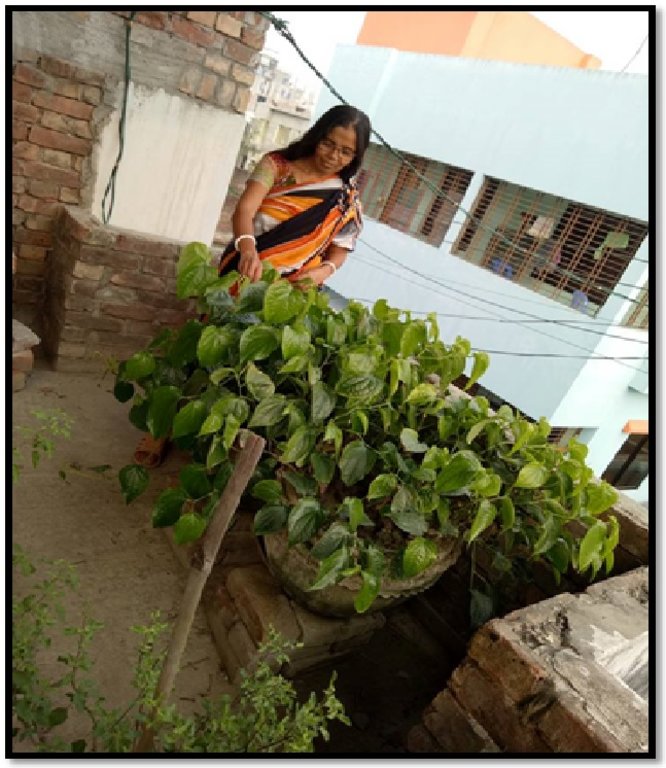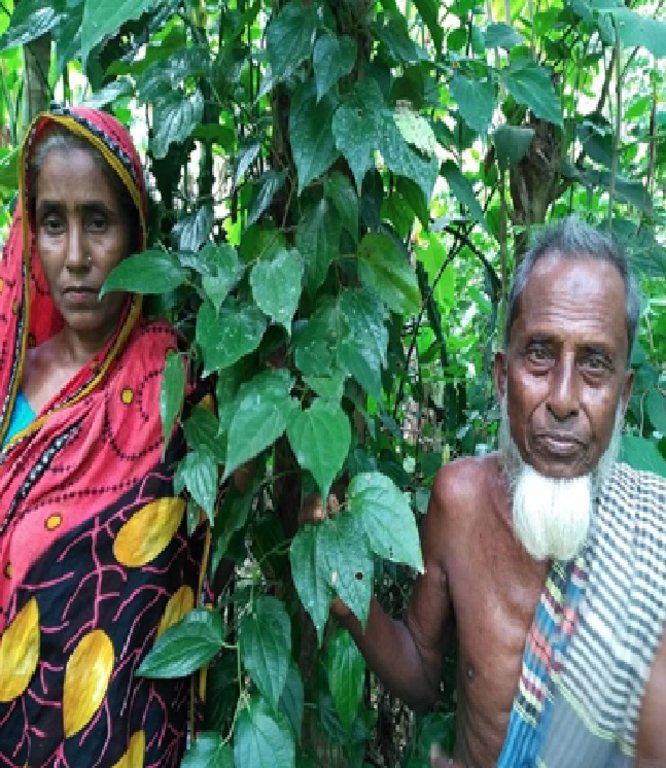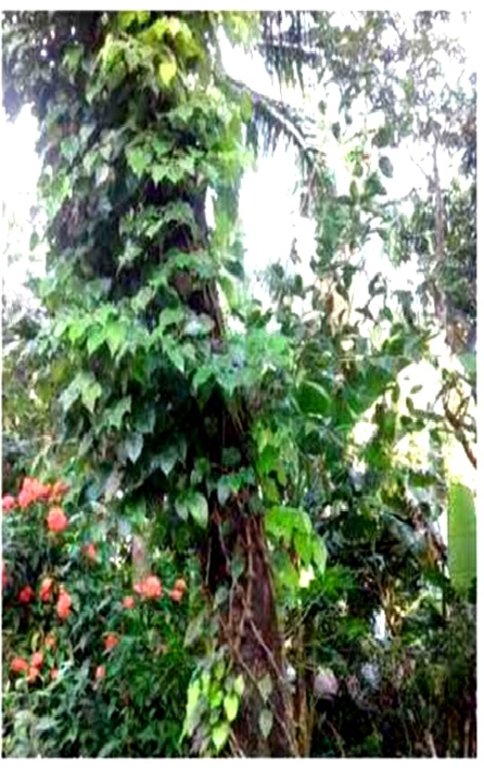Choi cultivation- a profitable crop for saline areas of Bangladesh [บังกลาเทศ]
- ผู้สร้างสรรค์:
- การอัพเดท:
- ผู้รวบรวม: Jalal Uddin Md. Shoaib
- ผู้เรียบเรียง: –
- ผู้ตรวจสอบ: Rima Mekdaschi Studer, William Critchley
Morich lota chash
technologies_5769 - บังกลาเทศ
ดูส่วนย่อย
ขยายทั้งหมด ย่อทั้งหมด1. ข้อมูลทั่วไป
1.2 รายละเอียดที่ติดต่อได้ของผู้รวบรวมและองค์กรที่เกี่ยวข้องในการประเมินและการจัดเตรียมทำเอกสารของเทคโนโลยี
วิทยากรหลัก
co-compiler:
Islam Nazrul
Department of Agricultural Extension, Khulna
บังกลาเทศ
ชื่อของโครงการซึ่งอำนวยความสะดวกในการทำเอกสารหรือการประเมินเทคโนโลยี (ถ้าเกี่ยวข้อง)
Establishing National Land Use and Land Degradation Profile toward Mainstreaming SLM Practices in Sector Policies (ENALULDEP/SLM)1.3 เงื่อนไขการใช้ข้อมูลที่ได้บันทึกผ่านทาง WOCAT
ผู้รวบรวมและวิทยากรหลักยอมรับเงื่อนไขเกี่ยวกับการใช้ข้อมูลที่ถูกบันทึกผ่านทาง WOCAT:
ใช่
1.4 การเปิดเผยเรื่องความยั่งยืนของเทคโนโลยีที่ได้อธิบายไว้
เทคโนโลยีที่ได้อธิบายไว้นี้เป็นปัญหาของความเสื่อมโทรมโทรมของที่ดินหรือไม่ จึงไม่ได้รับการยอมรับว่าเป็นเทคโนโลยีเพื่อการจัดการที่ดินอย่างยั่งยืน:
ไม่ใช่
2. การอธิบายลักษณะของเทคโนโลยี SLM
2.1 การอธิบายแบบสั้น ๆ ของเทคโนโลยี
คำจำกัดความของเทคโนโลยี:
Choi Jhal (Piper chaba), locally called morich lota is a creeping vine that is grown in homesteads of saline areas. It is adapted to soil salinity, grows under shade and is a very high value crop. It remains green throughout the year, reducing evapotranspiration from the soil and hence reduces capillary rise of salinity from shallow ground water.
2.2 การอธิบายแบบละเอียดของเทคโนโลยี
คำอธิบาย:
Choi Jhal (Piper chaba), locally called morich lota is a creeping vine that is grown in homesteads of saline areas. It is adapted to soil salinity, grows under shade and is a very high value crop. It remains green throughout the year, reducing evapotranspiration from the soil and hence reduces capillary rise of salinity from shallow ground water. Choi Jhal locally called morich lota, is one of the most popular and unique spices in the south-western region of Bangladesh. It is a flowering vine grown in southern-western districts like Khulna and Satkhira. There are two types of choi found in these areas. One is a narrow vine (20 - 25 mm diameter) and the other is about 2. 5 - 5 cm in diameter. It creeps up to 8-10 meters when allowed to extend on ground. On the other hand it also climb up large trees like Mango (Mangifera indica), Jam (Syzygium cumini), Betel nut (Areca catechu), Coconut (Cocos nucifera) and Kafula (Lannea coromandelica), etc. Leaves and stems of the choi vine look like betel leafs (local name Paan; scientific name: Piper betle). Betel and choi are two species of the same family, Piperaceae. The leaves of choi are oval-shaped and about 5-6 cm long. The flowers are monoecious and blossom during the monsoon. The fruit looks similar to other varieties of long pepper, with an elongated shape that can grow up to 6 cm inches long. The fruit is red when ripe, and turns dark brown or black when dry. Chopped parts of the plant are cooked them with meat and fish, especially with mutton. The spicy pungent flavor of Choi Jhal is a year-round additive spice. In Thailand, P. chaba is known commonly as "Dee Plee”.
This technology was documented as one of the best practices that supports improved livelihoods of farmers who have no, or very little, cultivable land except their home yards. It is adapted to seasonal salinity in the dry season and waterlogging in monsoon. Pankhali is a village of Dacop Upazalia, Khulna where most of farmer practiced choi cultivation as their main income source. It is easy to propagate with cuttings of vines ideally of 50-75 cm with at least 4-5 nodes. Generally no chemical fertilizer is used for its cultivation, rather domestic waste or compost is used in ‘pits’ at the time of planting vine cuttings. The cuttings of vines are planted in April-May or November-December in relatively higher areas of the home gardens, with loamy soils. Choi is shade-loving. Approximately 2-2.5 ton/ha could be harvested after 5-6 years. It could be harvested after one year, but ideally it is better to harvest after 5 years. Farmers earn 1,000-1,500 BDT (US$1= 84 BDT) per kg from 5-year old choi. The mature roots are more valuable than the green vine. These days this product is marketed by many departmental stores of the city.
This expensive spice has great medicinal value, and tastes like pepper. It has been used to treat different kinds of diseases and it has a number of herbal uses, specially the antimicrobial and antioxidant active ingredients, Choi has 7% aromatic oil, 5% alkoloid and pepertin and in roots 13-15% peperin. The people of the area believe that it helps to remedy various diseases. One inch of choi can be used as medication for coughs. Its price depends on its thickness, and different thicknesses of Piper chaba taste different. Thicker ones are popular for its flesh and thinner ones for their spicy heat.
Commonly the twigs, stems or roots both fresh and dried forms are used in this area as a spice. Sometimes it is ground and used as an ingredient in a variety of sauces and pastes. It is a relatively expensive spice and the roots are usually more expensive than the stems because of their stronger aroma. It is mainly used as a taste enhancer. It makes the food spicier. It is also used in Jhalmori, Pickles, Halim and for making tasty soups.
2.3 รูปภาพของเทคโนโลยี
2.5 ประเทศภูมิภาค หรือสถานที่ตั้งที่เทคโนโลยีได้นำไปใช้และได้รับการครอบคลุมโดยการประเมินนี้
ประเทศ:
บังกลาเทศ
ข้อมูลจำเพาะเพิ่มเติมของสถานที่ตั้ง :
It is spread over most of the districts of Khulna division
ระบุการกระจายตัวของเทคโนโลยี:
- กระจายไปอย่างสม่ำเสมอในพื้นที่
If precise area is not known, indicate approximate area covered:
- 10-100 ตร.กม.
Is/are the technology site(s) located in a permanently protected area?
ไม่ใช่
แสดงความคิดเห็น:
Choi Jhal is grown in most of the homesteads as a valuable crop.
Map
×2.6 วันที่การดำเนินการ
ถ้าไม่รู้ปีที่แน่นอน ให้ระบุวันที่โดยประมาณ:
- 10-50 ปี
2.7 คำแนะนำของเทคโนโลยี
ให้ระบุว่าเทคโนโลยีถูกแนะนำเข้ามาอย่างไร:
- ด้วยการริเริ่มของผู้ใช้ที่ดินเอง
- เป็นส่วนหนึ่งของระบบแบบดั้งเดิมที่ทำก้นอยู่ (> 50 ปี)
3. การจัดประเภทของเทคโนโลยี SLM
3.1 วัตถุประสงค์หลักของเทคโนโลยี
- ปรับปรุงการผลิตให้ดีขึ้น
- ลด ป้องกัน ฟื้นฟู การเสื่อมโทรมของที่ดิน
- สร้างผลกระทบทางด้านเศรษฐกิจที่เป็นประโยชน์
- cover crop when allowed to creep on ground
3.2 ประเภทของการใช้ที่ดินในปัจจุบันที่ได้นำเทคโนโลยีไปใช้
Land use mixed within the same land unit:
ไม่ใช่

พื้นที่ปลูกพืช
- การปลูกพืชยืนต้นที่ไม่มีเนื้อไม้
Perennial (non-woody) cropping - Specify crops:
- herbs, chili, capsicum

อื่น ๆ
ระบุ:
Homestead area
ข้อสังเกต:
A small part of homesteads are used to grow Choi Jhal or it is planted near a larger tree like Mango, Kafula ( Lenea coromondalica), coconut etc. It is a shade-loving crop. Therefore homesteads are best for this crop.
3.3 Has land use changed due to the implementation of the Technology?
Has land use changed due to the implementation of the Technology?
- No (Continue with question 3.4)

อื่น ๆ
ระบุ:
Homestead areas
3.4 การใช้น้ำ
การใช้น้ำของที่ดินที่มีการใช้เทคโนโลยีอยู่:
- น้ำฝนร่วมกับการชลประทาน
แสดงความคิดเห็น:
It may require occasional irrigation at the initial stage
3.5 กลุ่ม SLM ที่ตรงกับเทคโนโลยีนี้
- สวนครัว
3.6 มาตรการ SLM ที่ประกอบกันเป็นเทคโนโลยี

มาตรการจัดการพืช
- A1: พืช/สิ่งปกคลุมดิน
- A2: อินทรียวัตถุในดิน/ความอุดมสมบูรณ์ในดิน
3.7 รูปแบบหลักของการเสื่อมโทรมของที่ดินที่ได้รับการแก้ไขโดยเทคโนโลยี

การเสื่อมโทรมของดินทางด้านเคมี
- Cs (Salinization/alkalinization): การสะสมเกลือหรือการทำให้เป็นด่าง

อื่น ๆ
ระบุ:
It helps to reduce soil salinity
3.8 การป้องกัน การลดลง หรือการฟื้นฟูความเสื่อมโทรมของที่ดิน
ระบุเป้าหมายของเทคโนโลยีกับความเสื่อมโทรมของที่ดิน:
- ไม่สามารถใช้ได้
4. ข้อมูลจำเพาะด้านเทคนิค กิจกรรมการนำไปปฏิบัติใช้ ปัจจัยนำเข้า และค่าใช้จ่าย
4.1 แบบแปลนทางเทคนิคของเทคโนโลยี
ข้อมูลจำเพาะด้านเทคนิค (แบบแปลนทางเทคนิคของเทคโนโลยี):
Choi Jhal (Piper chaba) vines are generally grown as farmers choice, where they are mainly allowed to creep along the ground or allowed to creep up large trees like Mango, Kafula, Coconut etc. Vines are planted in small pits filled with kitchen waste or compost. Vines generally are 50-75 cm with 4-5 nodes.
ผู้เขียน:
jalal Uddin Md. Shoaib
วันที่:
07/01/2020
ข้อมูลจำเพาะด้านเทคนิค (แบบแปลนทางเทคนิคของเทคโนโลยี):
Choi Jhal creeping with large tree
ผู้เขียน:
jalal Uddin Md. Shoaib
วันที่:
07/01/2020
ข้อมูลจำเพาะด้านเทคนิค (แบบแปลนทางเทคนิคของเทคโนโลยี):
Choi Jhal Creeping with stick to climb on platform
ผู้เขียน:
jalal Uddin Md. Shoaib
วันที่:
07/01/2020
4.2 ข้อมูลทั่วไปเกี่ยวกับการคำนวณปัจจัยนำเข้าและค่าใช้จ่าย
ให้ระบุว่าค่าใช้จ่ายและปัจจัยนำเข้าได้รับการคำนวณอย่างไร:
- ต่อพื้นที่ที่ใช้เทคโนโลยี
ระบุขนาดและหน่วยพื้นที่:
approximately 0.01ha
อื่นๆ หรือสกุลเงินประจำชาติ (ระบุ):
BDT
If relevant, indicate exchange rate from USD to local currency (e.g. 1 USD = 79.9 Brazilian Real): 1 USD =:
84.95
ระบุค่าเฉลี่ยของค่าจ้างในการจ้างแรงงานต่อวัน:
500
4.3 กิจกรรมเพื่อการจัดตั้ง
| กิจกรรม | Timing (season) | |
|---|---|---|
| 1. | Bed or PIT preparation | April-May, Nov-Dec |
| 2. | Planting | April-May, Nov-Dec |
4.4 ค่าใช้จ่ายของปัจจัยนำเข้าที่จำเป็นสำหรับการจัดตั้ง
| ปัจจัยนำเข้า | หน่วย | ปริมาณ | ค่าใช้จ่ายต่อหน่วย | ค่าใช้จ่ายทั้งหมดต่อปัจจัยนำเข้า | %ของค่าใช้จ่ายที่ก่อให้เกิดขึ้นโดยผู้ใช้ที่ดิน | |
|---|---|---|---|---|---|---|
| แรงงาน | Labour | 1 | 4.0 | 500.0 | 2000.0 | 100.0 |
| วัสดุด้านพืช | Cuttings/ vine of Choi (Own produce) | 1 | 20.0 | 10.0 | 200.0 | |
| ปุ๋ยและสารฆ่า/ยับยั้งการเจริญเติบโตของสิ่งมีชีวิต (ไบโอไซด์) | Compost (Own) | LS | 1.0 | 50.0 | 50.0 | |
| ค่าใช้จ่ายทั้งหมดของการจัดตั้งเทคโนโลยี | 2250.0 | |||||
| Total costs for establishment of the Technology in USD | 26.49 | |||||
If you are unable to break down the costs in the table above, give an estimation of the total costs of establishing the Technology:
2250.0
ถ้าผู้ใช้ที่ดินรับภาระน้อยกว่า 100% ของค่าใช้จ่าย ให้ระบุว่าใครเป็นผู้รับผิดชอบส่วนที่เหลือ:
100%
4.5 การบำรุงรักษาสภาพหรือกิจกรรมที่เกิดขึ้นเป็นประจำ
| กิจกรรม | ช่วงระยะเวลา/ความถี่ | |
|---|---|---|
| 1. | Watch and ward | as necessary |
4.6 ค่าใช้จ่ายของปัจจัยนำเข้าและกิจกรรมที่เกิดขึ้นเป็นประจำที่ต้องการการบำรุงรักษา (ต่อปี)
If you are unable to break down the costs in the table above, give an estimation of the total costs of maintaining the Technology:
500.0
ถ้าผู้ใช้ที่ดินรับภาระน้อยกว่า 100% ของค่าใช้จ่าย ให้ระบุว่าใครเป็นผู้รับผิดชอบส่วนที่เหลือ:
100%
แสดงความคิดเห็น:
It is very easy to maintain. Only to look after the crop while creeping.
4.7 ปัจจัยสำคัญที่สุดที่มีผลกระทบต่อค่าใช้จ่าย
ปัจจัยสำคัญที่สุดที่มีผลกระทบต่อค่าใช้จ่ายต่างๆ:
not applicable
5. สิ่งแวดล้อมทางธรรมชาติและของมนุษย์
5.1 ภูมิอากาศ
ฝนประจำปี
- < 250 ม.ม.
- 251-500 ม.ม.
- 501-750 ม.ม.
- 751-1,000 ม.ม.
- 1,001-1,500 ม.ม.
- 1,501-2,000 ม.ม.
- 2,001-3,000 ม.ม.
- 3,001-4,000 ม.ม.
- > 4,000 ม.ม.
เขตภูมิอากาศเกษตร
- กึ่งชุ่มชื้น
5.2 สภาพภูมิประเทศ
ค่าเฉลี่ยความลาดชัน:
- ราบเรียบ (0-2%)
- ลาดที่ไม่ชัน (3-5%)
- ปานกลาง (6-10%)
- เป็นลูกคลื่น (11-15%)
- เป็นเนิน (16-30%)
- ชัน (31-60%)
- ชันมาก (>60%)
ธรณีสัณฐาน:
- ที่ราบสูง/ที่ราบ
- สันเขา
- ไหล่เขา
- ไหล่เนินเขา
- ตีนเนิน
- หุบเขา
ระดับความสูง:
- 0-100 เมตร
- 101-500 เมตร
- 501-1,000 เมตร
- 1,001-1,500 เมตร
- 1,501-2,000 เมตร
- 2,001-2,500 เมตร
- 2,501-3,000 เมตร
- 3,001-4,000 เมตร
- > 4,000 เมตร
ให้ระบุถ้าเทคโนโลยีได้ถูกนำไปใช้:
- ไม่เกี่ยวข้อง
5.3 ดิน
ค่าเฉลี่ยความลึกของดิน:
- ตื้นมาก (0-20 ซ.ม.)
- ตื้น (21-50 ซ.ม.)
- ลึกปานกลาง (51-80 ซ.ม.)
- ลึก (81-120 ซ.ม.)
- ลึกมาก (>120 ซ.ม.)
เนื้อดิน (ดินชั้นบน):
- ปานกลาง (ดินร่วน ทรายแป้ง)
เนื้อดินล่าง (> 20 ซ.ม.ต่ำจากผิวดิน):
- ปานกลาง (ดินร่วน ทรายแป้ง)
อินทรียวัตถุในดิน:
- สูง (>3%)
5.4 ความเป็นประโยชน์และคุณภาพของน้ำ
ระดับน้ำใต้ดิน:
5-50 เมตร
น้ำไหลบ่าที่ผิวดิน:
ปานกลาง
คุณภาพน้ำ (ที่ยังไม่ได้บำบัด):
ใช้ประโยชน์ไม่ได้
Water quality refers to:
surface water
ความเค็มของน้ำเป็นปัญหาหรือไม่:
ใช่
กำลังเกิดน้ำท่วมในพื้นที่หรือไม่:
ไม่ใช่
5.5 ความหลากหลายทางชีวภาพ
ความหลากหลายทางชนิดพันธุ์:
- สูง
ความหลากหลายของแหล่งที่อยู่:
- สูง
5.6 ลักษณะของผู้ใช้ที่ดินที่นำเทคโนโลยีไปปฏิบัติใช้
อยู่กับที่หรือเร่ร่อน:
- อยู่กับที่
แนวทางการตลาดของระบบการผลิต:
- mixed (subsistence/ commercial)
รายได้ที่มาจากนอกฟาร์ม:
- < 10% ของรายได้ทั้งหมด
ระดับของความมั่งคั่งโดยเปรียบเทียบ:
- จน
- พอมีพอกิน
เป็นรายบุคคล/ครัวเรือน:
- เป็นรายบุคคล/ครัวเรือน
ระดับของการใช้เครื่องจักรกล:
- งานที่ใช้แรงกาย
เพศ:
- หญิง
- ชาย
อายุของผู้ใช้ที่ดิน:
- วัยกลางคน
- ผู้สูงอายุ
5.7 Average area of land used by land users applying the Technology
- < 0.5 เฮกตาร์
- 0.5-1 เฮกตาร์
- 1-2 เฮกตาร์
- 2-5 เฮกตาร์
- 5-15 เฮกตาร์
- 15-50 เฮกตาร์
- 50-100 เฮกตาร์
- 100-500 เฮกตาร์
- 500-1,000 เฮกตาร์
- 1,000-10,000 เฮกตาร์
- >10,000 เฮกตาร์
พิจารณาว่าเป็นขนาดเล็ก กลาง หรือขนาดใหญ่ (ซึ่งอ้างอิงถึงบริบทระดับท้องถิ่น):
- ขนาดเล็ก
5.8 กรรมสิทธิ์ในที่ดิน สิทธิในการใช้ที่ดินและสิทธิในการใช้น้ำ
กรรมสิทธิ์ในที่ดิน:
- รายบุคคล ได้รับสิทธิครอบครอง
สิทธิในการใช้ที่ดิน:
- เข้าถึงได้แบบเปิด (ไม่ได้จัดระเบียบ)
- รายบุคคล
สิทธิในการใช้น้ำ:
- เข้าถึงได้แบบเปิด (ไม่ได้จัดระเบียบ)
Are land use rights based on a traditional legal system?
ใช่
5.9 การเข้าถึงบริการและโครงสร้างพื้นฐาน
สุขภาพ:
- จน
- ปานกลาง
- ดี
การศึกษา:
- จน
- ปานกลาง
- ดี
ความช่วยเหลือทางด้านเทคนิค:
- จน
- ปานกลาง
- ดี
การจ้างงาน (เช่น ภายนอกฟาร์ม):
- จน
- ปานกลาง
- ดี
ตลาด:
- จน
- ปานกลาง
- ดี
พลังงาน:
- จน
- ปานกลาง
- ดี
ถนนและการขนส่ง:
- จน
- ปานกลาง
- ดี
น้ำดื่มและการสุขาภิบาล:
- จน
- ปานกลาง
- ดี
บริการด้านการเงิน:
- จน
- ปานกลาง
- ดี
6. ผลกระทบและสรุปคำบอกกล่าว
6.1 ผลกระทบในพื้นที่ดำเนินการ (On-site) จากการใช้เทคโนโลยี
ผลกระทบทางด้านเศรษฐกิจและสังคม
รายได้และค่าใช้จ่าย
รายได้จากฟาร์ม
แสดงความคิดเห็น/ระบุ:
Home yards could be used to grow Choi with other crops/vegetables.
ผลกระทบทางด้านเศรษฐกิจและสังคมอื่น ๆ
Adopt seasonal salinity in dry seaspm and some what water logging in monsoon; a high value crop that increased cash income.
แสดงความคิดเห็น/ระบุ:
The coastal area is saline in dry season and water logging in monsoon restricts cropping through out the year. Choi is a high value spice crop, could be grown in small areas of homesteads with other crops like vegetables etc. Small farmers of the area use this crop to earn cash.
Specify assessment of on-site impacts (measurements):
Not applicable
6.2 ผลกระทบนอกพื้นที่ดำเนินการ (Off-site) จากการใช้เทคโนโลยี
Specify assessment of off-site impacts (measurements):
Not applicable
6.3 การเผชิญและความตอบสนองของเทคโนโลยีต่อการเปลี่ยนแปลงสภาพภูมิอากาศที่ค่อยเป็นค่อยไป และสภาพรุนแรงของภูมิอากาศ / ภัยพิบัติ (ที่รับรู้ได้โดยผู้ใช้ที่ดิน)
แสดงความคิดเห็น:
Not applicable
6.4 การวิเคราะห์ค่าใช้จ่ายและผลประโยชน์ที่ได้รับ
ผลประโยชน์ที่ได้รับเปรียบเทียบกับค่าใช้จ่ายในการจัดตั้งเป็นอย่างไร (จากมุมมองของผู้ใช้ที่ดิน)
ผลตอบแทนระยะสั้น:
ด้านบวก
ผลตอบแทนระยะยาว:
ด้านบวกอย่างมาก
ผลประโยชน์ที่ได้รับเปรียบเทียบกับค่าใช้จ่ายในการบำรุงรักษาหรือต้นทุนที่เกิดขึ้นซ้ำอีก เป็นอย่างไร (จากมุมมองของผู้ใช้ที่ดิน)
ผลตอบแทนระยะสั้น:
ด้านบวกอย่างมาก
ผลตอบแทนระยะยาว:
ด้านบวกอย่างมาก
6.5 การปรับตัวของเทคโนโลยี
- > 50%
ถ้ามีข้อมูลให้บอกปริมาณด้วย (จำนวนของครัวเรือนหรือครอบคลุมพื้นที่):
Many of the homesteads already used to growing choi jahl
Of all those who have adopted the Technology, how many did so spontaneously, i.e. without receiving any material incentives/ payments?
- 91-100%
6.6 การปรับตัว
เทคโนโลยีได้รับการปรับเปลี่ยนเมื่อเร็วๆนี้ เพื่อให้ปรับตัวเข้ากับสภาพที่กำลังเปลี่ยนแปลงหรือไม่:
ใช่
อื่น ๆ (ระบุ):
At present nursery has been emerging to market saplings of choi jhalet
ให้ระบุการปรับตัวของเทคโนโลยี (การออกแบบ วัสดุหรือชนิดพันธุ์ เป็นต้น):
Nursery has been developed
6.7 จุดแข็ง / ข้อได้เปรียบ / โอกาสของเทคโนโลยี
| จุดแข็ง / ข้อได้เปรียบ / โอกาสในทัศนคติของผู้ใช้ที่ดิน |
|---|
| Can earn cash money |
| Can use for own family |
| Can be grown in small area in homesteads |
| Almost all parts of the Choi Jhal are edible |
| จุดแข็ง / ข้อได้เปรียบ / โอกาสในทัศนคติของผู้รวบรวมหรือวิทยากรหลัก |
|---|
| Easy to propagate |
| No use of chemical fertilizer |
| Marketing of the crop increased |
| Added menu of restaurants bigger cities |
6.8 จุดอ่อน / ข้อเสียเปรียบ / ความเสี่ยงของเทคโนโลยีและวิธีการแก้ไข
| จุดอ่อน / ข้อเสียเปรียบ / ความเสี่ยงในทัศนคติของผู้ใช้ที่ดิน | มีวิธีการแก้ไขได้อย่างไร |
|---|---|
| Fungus infection at early stage | Use of anti fungus |
| จุดอ่อน / ข้อเสียเปรียบ / ความเสี่ยงในทัศนคติของผู้รวบรวมหรือวิทยากรหลัก | มีวิธีการแก้ไขได้อย่างไร |
|---|---|
| Confined in Khulna division | Extension message could be developed |
| Preservation of green Choi | Harvesting matured parts or has to be market quickly. |
7. การอ้างอิงและการเชื่อมต่อ
7.1 วิธีการและแหล่งข้อมูล
- ไปเยี่ยมชมภาคสนาม การสำรวจพื้นที่ภาคสนาม
10 homesteads
- การสัมภาษณ์กับผู้ใช้ที่ดิน
10
- การสัมภาษณ์ผู้เชี่ยวชาญด้าน SLM หรือผู้ชำนาญ
2
- การเก็บรวบรวมมาจากรายงานและเอกสารที่มีอยู่
4
วันที่เก็บรวบรวมข้อมูล(ภาคสนาม) :
07/01/2020
7.3 Links to relevant online information
ชื่อเรื่องหรือคำอธิบาย:
Choi Jhal: The culinary fire of Bengal
URL:
https://www.dhakatribune.com/bangladesh/nation/2020/01/09/choi-jhal-the-culinary-fire-of-bengal
ชื่อเรื่องหรือคำอธิบาย:
Chui Jhal is a traditional Khulna's spice that brings water to the tongue
URL:
https://www.orchidshade.com/2020/09/chui-jhal-is-traditional-khulna-spice.html
ชื่อเรื่องหรือคำอธิบาย:
Piper chaba
URL:
https://en.wikipedia.org/wiki/Piper_chaba
7.4 General comments
The crop can be grown in small home gardens especially on higher ground. It is adapted to soil salinity, grows under shade and is a very high value crop. It remains green throughout the year, reducing evapotranspiration from the soil and hence reduces capillary rise of salinity from shallow ground water.
ลิงก์และโมดูล
ขยายทั้งหมด ย่อทั้งหมดลิงก์
ไม่มีลิงก์
โมดูล
ไม่มีโมดูล



